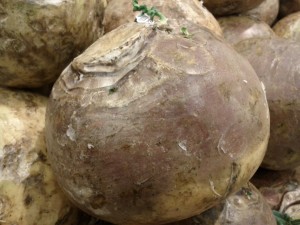 Turnips have been eaten since prehistoric times and originate from many areas in Europe and Asia. Starchy like a potato, it only contains a third of the calories that a potato has and contains many antioxidants, which makes an excellent alternative choice when considering side dishes for your next meal.
Turnips have been eaten since prehistoric times and originate from many areas in Europe and Asia. Starchy like a potato, it only contains a third of the calories that a potato has and contains many antioxidants, which makes an excellent alternative choice when considering side dishes for your next meal.
So what exactly is this bulb-shaped vegetable and why is it so good for you?
The turnip is a member of the cruciferae, or mustard family, and is also related to cabbage, cauliflower and rutabaga. Unlike many root vegetables, both its roots and its greens are edible and can be used in different recipes. It’s rich in essential nutrients, but low in calories and in sugar, contains no fat, sodium or cholesterol, making it ideal for those following a Candida diet or those who need to follow a low-calorie diet. A cup of cooked turnip contains only 30 calories, compared to a cup of beets, which contains 70 calories, or parsnips, which has over 120 calories per cup!
Vitamin C Content
Turnips also contain important amounts of Vitamin C, the antioxidant that helps fight off viruses, boosts your immune system and contributes to your body’s ability to absorb iron. Vitamin C isn’t only found in citrus fruits! Just one small cup of cooked turnip gives you 18 grams of vitamin C, roughly 30% of your recommended daily intake – not bad for a root vegetable that can survive harsh winters.
Turnip Health benefits:
1. Helps Prevent Cancer:
Because they contain high levels of antioxidants and phytonutrients, turnips can help reduce the risk of cancer. The glucosinolate and vitamin A levels in turnip greens are excellent. Glucosinolates can help the stomach and liver process and eliminate toxins, flushing them out of your system.
2. Anti-inflammatory:
Turnips and turnip greens contain outstanding amounts of folate, or folic acid, vitamin K, and omega-3 fatty acids- all excellent anti-inflammatory properties, ultimately reducing the risk of heart disease, arthritis and other diseases caused by chronic inflammation.
3. Promotes bone growth:
Would you guess that turnips contain sufficient amounts of both calcium and potassium? Yes! And both of those minerals are needed to prevent osteoporosis.
4. Can help you lose weight:
Having up to 20% of the recommended daily intake of fiber, turnip greens can help you feel fuller, longer. Being also a low-calorie but nutrient-dense food, turnips can be consumed without the guilt!
The Nutrient Breakdown:
| Principle | Nutrient Value | Percentage of RDA |
| Energy | 28 Kcal | 1.5% |
| Carbohydrates | 6.43 g | 5% |
| Protein | 0.90 g | 1.5% |
| Total Fat | 0.10 g | <1% |
| Cholesterol | 0 mg | 0% |
| Dietary Fiber | 1.8 g | 5% |

How to choose, store, and prepare Turnips
Even though turnips can be purchased year round, they are most fresh in the winter months, between October and March. When shopping for turnips, look for fresh roots that are smaller, more firm, and rounder – these will have a more mild and sweet flavour than the larger, more fibrous roots.
TIP: Do remove the top greens from the turnip roots once you get home however, otherwise the greens will continue to absorb the nutrients from the roots.
Turnip roots can be stored for several weeks in the refrigerator in high humidity. The turnip greens however, should be eaten within a few days, since they do not last long. Whether or not you decide to peel the turnip is up to you, but older matured turnips tend to have a tougher skin that is better peeled off.
While turnips can be added to your stews and soups and can be cooked just the way potatoes are, turnip greens can be steamed, sauteed, or added to your favorite salad recipes.
Here is my simple and savory turnip recipe:
Turnip “French” Fries
Makes about 8 servings
Ingredients:
3 lbs turnips (approx. 6 small turnips)
1/4 tsp sea salt
1 tbsp unpasteurized honey
2 tbsp (15 mL) extra virgin olive oil
1 tsp lemon juice
Instructions:
- Preheat oven to 425 °F (220 °C).
- Line a baking sheet with a piece of aluminum foil and lightly grease.
- Peel the turnips, and cut into French fry-sized sticks, about 1/3 by 4 inches.
- In a large bowl, mix together the olive oil, honey, lemon juice, and sea salt. Add the turnips and toss into the mixed sauce to coat evenly.
- Spread turnips onto the prepared baking sheet.
- Bake in preheated oven until the outside is crispy, and the inside is tender, about 20 minutes. Serve immediately.
Warning: Turnips are not for everyone.
While many of us can reap the benefits of the turnip, there are those who should avoid it as it may have adverse effects on their health. For example, since they can affect a person’s thyroid ability to take up iodine, those with thyroid problems should avoid eating turnips.
Also, turnips and turnip greens contain traces of oxalic acid, so those who follow a low oxalate diet to prevent kidney stones should try to avoid these roots. If consumed, follow up with a lot of water to reduce the risk of stones.
Did you like this article? What are your thoughts about turnips? Have you made turnip fries? Share your comments with us below! Also, help spread the word by using the Twitter and Facebook links below to share this article with your friends.
Sources:
http://www.nutrition-and-you.com/turnips.html
http://www.alive.com/articles/view/19473/turnips_are_tops_for_health
http://healthyeating.sfgate.com/advantages-turnips-2374.html


